Journal of Arid Meteorology ›› 2025, Vol. 43 ›› Issue (3): 435-449.DOI: 10.11755/j.issn.1006-7639-2025-03-0435
• Articles • Previous Articles Next Articles
Diagnostic analysis of trigger and maintenance mechanism associated with a rainstorm over Liaodong Peninsula
LIANG Jun1( ), JIA Xuxuan1,2, ZHANG Shengjun2, FENG Chengcheng1, LI Tingting1, CHENG Hang1, LIU Xiaochu1
), JIA Xuxuan1,2, ZHANG Shengjun2, FENG Chengcheng1, LI Tingting1, CHENG Hang1, LIU Xiaochu1
- 1. Dalian Meteorological Observatory, Dalian 116001, Liaoning, China
2. State Key Laboratory of Severe Weather, Chinese Academy of Meteorological Sciences, Beijing 100081, China
-
Received:2025-02-17Revised:2025-05-06Online:2025-06-30Published:2025-07-12
辽东半岛一次大暴雨过程触发和维持机制分析
梁军1( ), 贾旭轩1,2, 张胜军2, 冯呈呈1, 李婷婷1, 程航1, 刘晓初1
), 贾旭轩1,2, 张胜军2, 冯呈呈1, 李婷婷1, 程航1, 刘晓初1
- 1.辽宁省大连市气象台,辽宁 大连 116001
2.中国气象科学研究院灾害天气国家重点实验室,北京 100081
-
作者简介:梁军(1967—),女,正高级工程师,主要从事短期天气预报及应用技术研究。E-mail:qinldj@163.com。 -
基金资助:国家重点研发计划项目(2023YFC3008501);中国气象科学研究院灾害天气国家重点实验室开放课题(2024LASW-B14);及环渤海区域海洋气象科技协同创新项目(QYXM202208);及环渤海区域海洋气象科技协同创新项目(QYXM202402);及环渤海区域海洋气象科技协同创新项目(QYXM202403)
CLC Number:
Cite this article
LIANG Jun, JIA Xuxuan, ZHANG Shengjun, FENG Chengcheng, LI Tingting, CHENG Hang, LIU Xiaochu. Diagnostic analysis of trigger and maintenance mechanism associated with a rainstorm over Liaodong Peninsula[J]. Journal of Arid Meteorology, 2025, 43(3): 435-449.
梁军, 贾旭轩, 张胜军, 冯呈呈, 李婷婷, 程航, 刘晓初. 辽东半岛一次大暴雨过程触发和维持机制分析[J]. 干旱气象, 2025, 43(3): 435-449.
share this article
Add to citation manager EndNote|Ris|BibTeX
URL: http://www.ghqx.org.cn/EN/10.11755/j.issn.1006-7639-2025-03-0435

Fig.1 The distribution of rainfall amount in Liaodong Peninsula from 20:00 on 3 to 14:00 on 4 (a) and from 20:00 on 4 to 14:00 on 5 (b) August 2017 (Unit: mm)

Fig.2 The hourly precipitation at Shahekou (a), Taling (b) and Shihuiyao (c) stations from 14:00 on 3 to 11:00 on 4,Tongxing (d) and Donghualu (e) stations from 21:00 on 4 to 14:00 on 5 August 2017

Fig.3 The 500 hPa height fields (black solid lines, Unit: dagpm) and temperature fields (red dashed lines, Unit: ℃), 200 hPa wind speed (the color shaded, Unit: m·s-1)at 20:00 on 3(a)and 20:00 on 4(c)August 2017;the 850 hPa wind fields (wind vectors, Unit: m·s-1) and water vapor flux fields (the color shaded, Unit: g·cm-1·hPa-1·s-1) at 02:00 on 4 (b) and 02:00 on 5 (d) August 2017 (The red solid dot indicates the TC centers of Noru, the black thick solid line is upper-level trough, the solid red line is the shear line; the red triangle shows Liaodong Peninsula, the same as below)

Fig.4 The distribution of TBB (the color shaded, Unit: ℃, TBB≤-15 ℃) from FY-2G satellite, 850 hPa water vapor flux divergence (purple dashed lines,Unit: 10-7 g·cm-2·hPa-1·s-1) and equivalent potential temperature(gray solid lines, Unit: K)at 02:00 (a) and 08:00 (b) on 4 August 2017 (The black thick solid lines are the shear lines, the same as below)

Fig.5 The distribution of TBB (the color shaded, Unit: ℃, TBB≤-15 ℃) from FY-2G satellite, 850 hPa water vapor flux divergence (purple dashed lines,Unit: 10-7 g·cm-2·hPa-1·s-1) and equivalent potential temperature(gray solid lines, Unit: K)at 02:00 (a) and 08:00 (b) on 5 August 2017
| 时 间 | 站 点 | CAPE/(J·kg-1) | CIN/(J·kg-1) | Tt/℃ | LCL/hPa | K/℃ | PW/mm | LI | θse/K | RH/% |
|---|---|---|---|---|---|---|---|---|---|---|
| 3日20:00 | 丹东 | 1 467.3 | 15.7 | 42 | 989 | 37 | 69 | -3.9 | 361 | 94 |
| 大连 | 893.1 | 6.7 | 47 | 975 | 42 | 63 | -4.0 | 358 | 94 | |
| 荣成 | 1 193.9 | 2.0 | 44 | 978 | 39 | 74 | -3.4 | 363 | 94 | |
| 4日08:00 | 丹东 | 13.2 | 247.2 | 42 | 961 | 36 | 65 | 0.4 | 345 | 83 |
| 大连 | 114.1 | 145.0 | 41 | 976 | 34 | 56 | 0.4 | 354 | 94 | |
| 荣成 | 663.4 | 0 | 41 | 992 | 40 | 78 | -2.0 | 362 | 100 | |
| 4日20:00 | 丹东 | 404.5 | 163.1 | 43 | 975 | 35 | 56 | -1.2 | 345 | 83 |
| 大连 | 1 175.9 | 0.1 | 41 | 991 | 39 | 59 | -1.0 | 354 | 94 | |
| 荣成 | 1 222.8 | 24.2 | 43 | 980 | 40 | 64 | -2.3 | 362 | 100 | |
| 5日08:00 | 丹东 | 1.1 | 501.2 | 47 | 976 | 34 | 60 | 1.4 | 340 | 89 |
| 大连 | 131.5 | 84.7 | 45 | 976 | 38 | 68 | -1.6 | 354 | 94 | |
| 荣成 | 1 204.0 | 8.9 | 43 | 980 | 30 | 63 | -4.3 | 363 | 94 |
Tab.1 Convective available potential energy (CAPE), convective inhibition energy (CIN), total temperature (Tt), lift condensation level (LCL), K index, precipitable water (PW), surface lifting index (LI), ground pseudo-equivalent potential temperature (θse) and ground relative humidity (RH) calculated from sounding stations in the rainstorm area
| 时 间 | 站 点 | CAPE/(J·kg-1) | CIN/(J·kg-1) | Tt/℃ | LCL/hPa | K/℃ | PW/mm | LI | θse/K | RH/% |
|---|---|---|---|---|---|---|---|---|---|---|
| 3日20:00 | 丹东 | 1 467.3 | 15.7 | 42 | 989 | 37 | 69 | -3.9 | 361 | 94 |
| 大连 | 893.1 | 6.7 | 47 | 975 | 42 | 63 | -4.0 | 358 | 94 | |
| 荣成 | 1 193.9 | 2.0 | 44 | 978 | 39 | 74 | -3.4 | 363 | 94 | |
| 4日08:00 | 丹东 | 13.2 | 247.2 | 42 | 961 | 36 | 65 | 0.4 | 345 | 83 |
| 大连 | 114.1 | 145.0 | 41 | 976 | 34 | 56 | 0.4 | 354 | 94 | |
| 荣成 | 663.4 | 0 | 41 | 992 | 40 | 78 | -2.0 | 362 | 100 | |
| 4日20:00 | 丹东 | 404.5 | 163.1 | 43 | 975 | 35 | 56 | -1.2 | 345 | 83 |
| 大连 | 1 175.9 | 0.1 | 41 | 991 | 39 | 59 | -1.0 | 354 | 94 | |
| 荣成 | 1 222.8 | 24.2 | 43 | 980 | 40 | 64 | -2.3 | 362 | 100 | |
| 5日08:00 | 丹东 | 1.1 | 501.2 | 47 | 976 | 34 | 60 | 1.4 | 340 | 89 |
| 大连 | 131.5 | 84.7 | 45 | 976 | 38 | 68 | -1.6 | 354 | 94 | |
| 荣成 | 1 204.0 | 8.9 | 43 | 980 | 30 | 63 | -4.3 | 363 | 94 |

Fig.6 The T-ln P charts at Shihuiyao Station at 00:00 on 4 (a), Dalian Station at 03:00 on 4 (b) and Donghualu Station at 02:00 on 5(c)August 2017 (the red line for temperature curve, the green line for dew point curve, and the black line for state curve, the blue dotted line for the height of 0 ℃ layer)
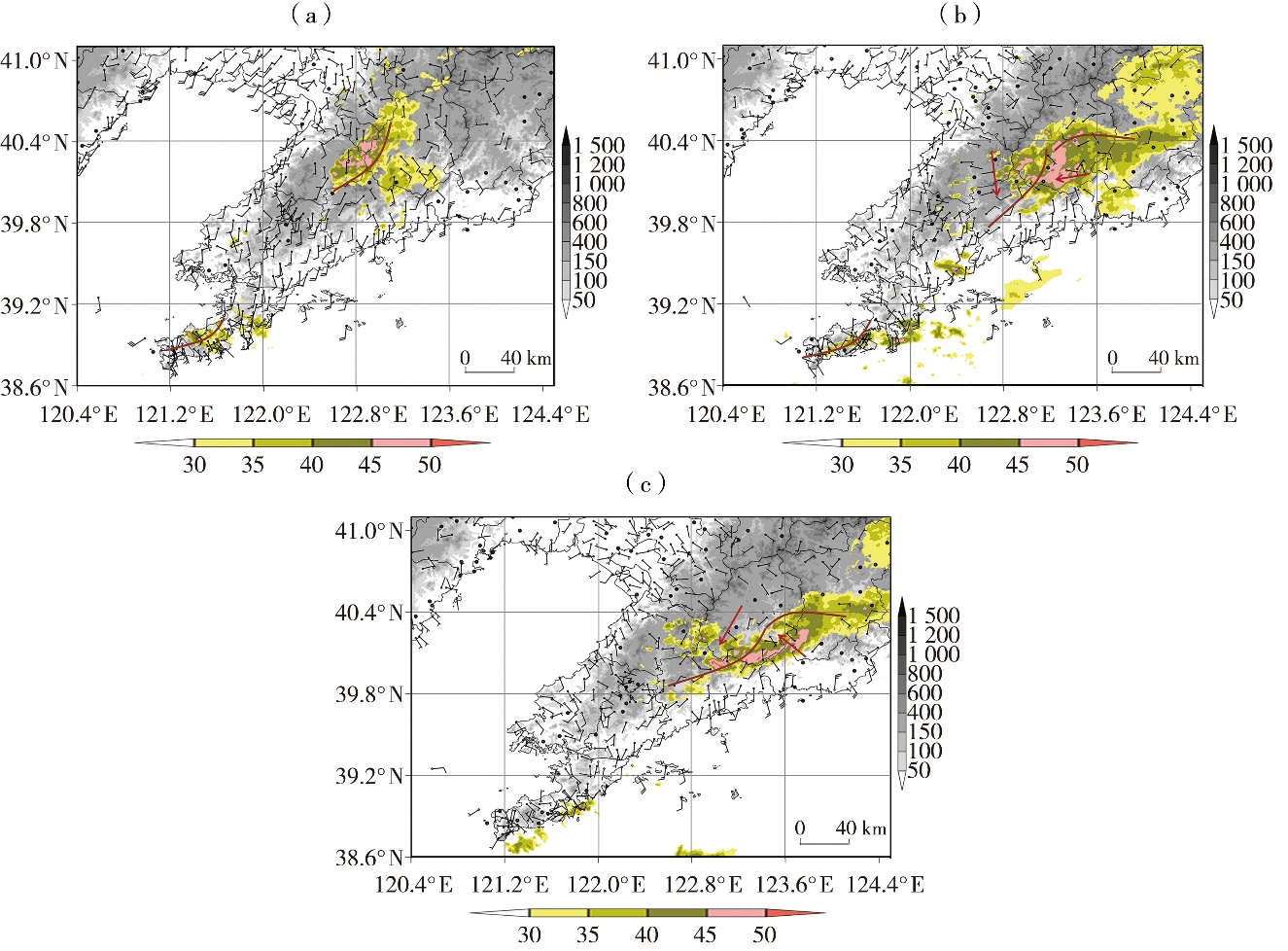
Fig.7 The 10 m wind fields (wind vectors,Unit:m·s-1) and reflectivity at the elevation of 0.5° (the color shaded, Unit: dBZ) from Dalian radar at 21:00 (a)on 3, and 05:00 (b), 07:00 (c) on 4 August 2017 (The grey shaded area denotes topography, Unit: m; the red solid lines are for convergence lines, the same as below)
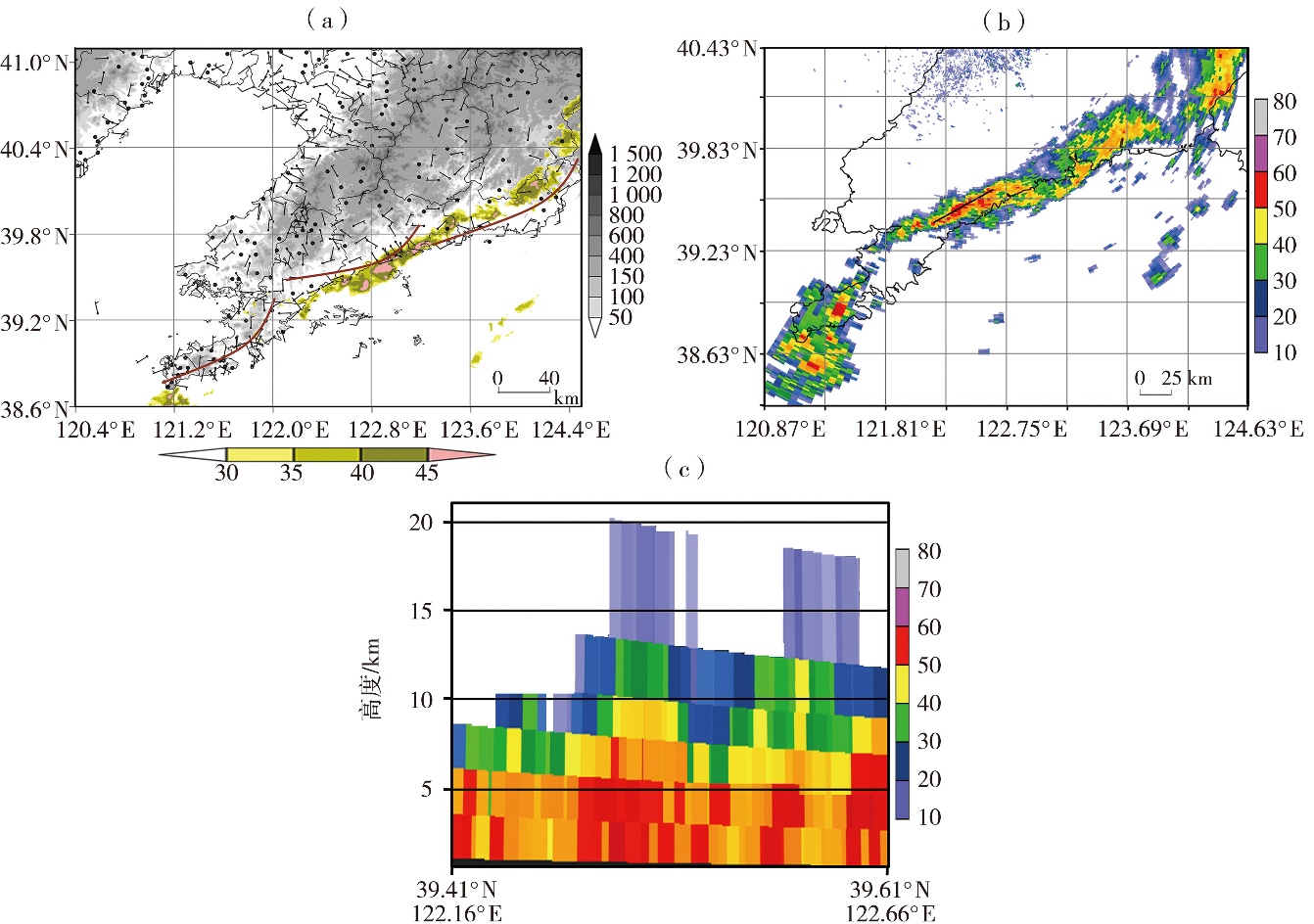
Fig.8 The 10 m wind fields (wind vectors, Unit:m·s-1) and reflectivity at the elevation of 0.5° (the color shaded, Unit: dBZ) from Dalian radar at 03:00 on 5 August (a),reflectivity at 0.5° elevation from Yingkou radar at 03:46 on 5 August (b) and the cross-section of reflectivity along the line in fig.8 (b) (Unit: dBZ) (c)
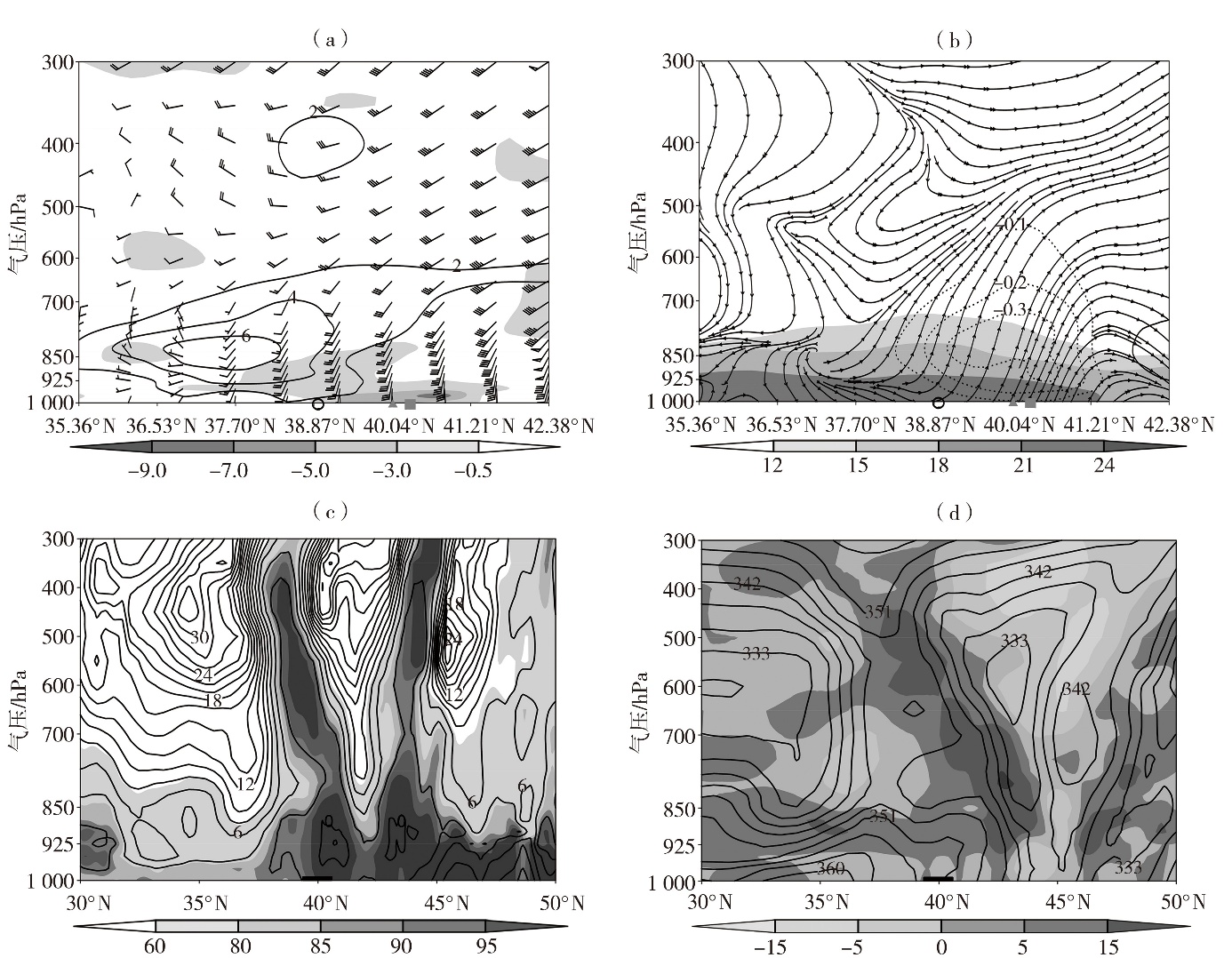
Fig.9 Vertical cross-sections along the line in fig.3 (b) (the shear line) for wind field (wind vectors, Unit: m·s-1), positive vorticity (solid lines) and divergence (the shaded areas for convergence areas) (Unit: 10-5s-1) (a), for vertical speed (dotted lines, Unit: Pa· s-1), specific humidity (the shaded areas, Unit: g·kg-1) and streamline of horizontal wind with vertical velocity (enlarged by 100 times) (b), the latitude-height cross sections along 123.1°E for relative humidity (the shaded areas, Unit: %) and the difference between temperature and dew-point (solid lines, Unit: ℃) (c), for equivalent potential temperature (solid lines, Unit: K) and temperature advection (the shaded, Unit: 10-4 ℃·s-1) (d) at 02:00 on 4 August 2017 (○ denotes Shahekou Station, ▲ denotes Taling Station, ■ denotes Shihuiyao Station, and bold regions on the abscissa indicate the range of heavy precipitation,the same as below)

Fig.10 The longitude-height cross sections of frontogenesis function (Unit: 10-10 K·m-1·s-1) along 40.0°N at 02:00 on 4 (a) and along 39.8°N at 02:00 on 5 (b) August 2017
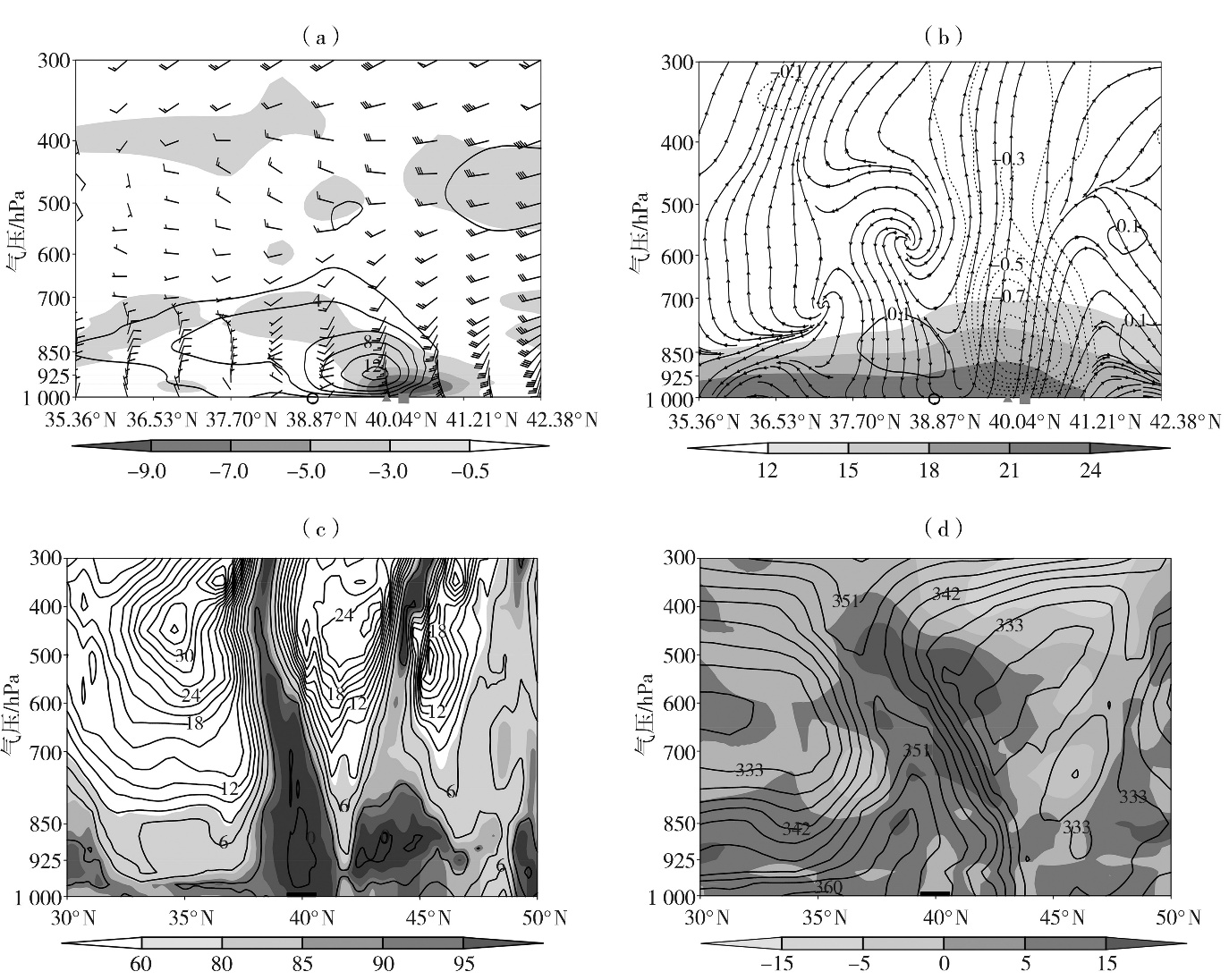
Fig.11 Vertical cross-sections along the line in fig.3 (b) (the shear line) for wind field (wind vectors, Unit: m·s-1), positive vorticity (solid lines) and divergence (the shaded areas for convergence areas) (Unit: 10-5s-1) (a), for vertical speed (dotted lines, Unit: Pa·s-1), specific humidity (the shaded areas for specific humidity≥12 g· kg-1) and streamline of horizontal wind with vertical velocity (enlarged by 100 times) (b), the latitude-height cross sections along 123.1°E for relative humidity (the shaded areas for relative humidity≥60%) and the difference between temperature and dew-point (solid lines, Unit: ℃) (c), for equivalent potential temperature (solid lines, Unit: K) and temperature advection (the shaded, Unit: 10-4 ℃·s-1) (d) at 08:00 on 4 August 2017
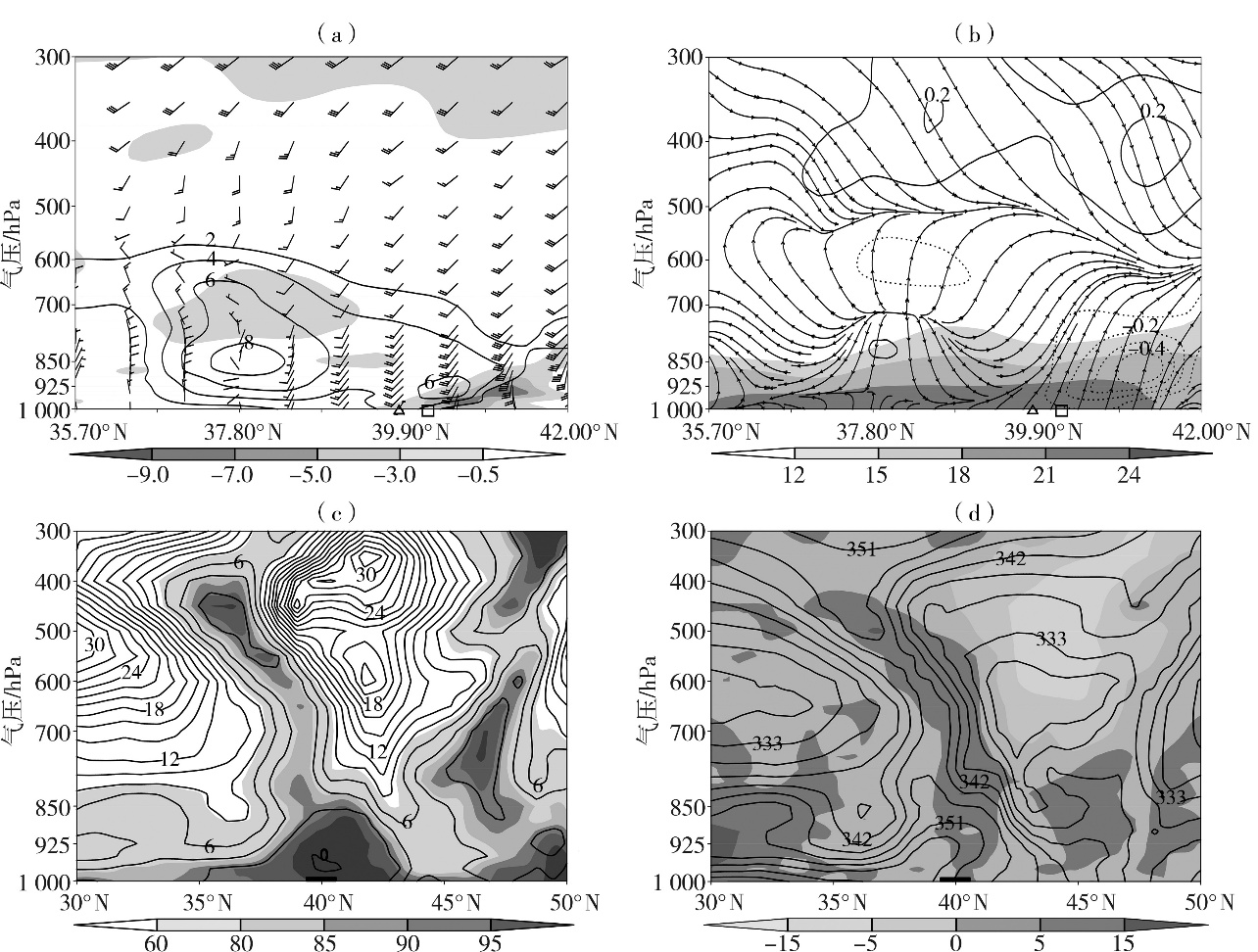
Fig.12 Vertical cross-sections along the line in fig.3(d) (the shear line) for wind field (wind vectors, Unit: m·s-1), positive vorticity (solid lines) and divergence (the shaded areas for convergence areas) (Unit: 10-5s-1) (a), for vertical speed (dotted lines, Unit: Pa·s-1), specific humidity (the shaded areas for specific humidity≥12 g·kg-1) and streamline of horizontal wind with vertical velocity (enlarged by 100 times) (b), the latitude-height cross sections along 123.3°E for relative humidity (the shaded areas for relative humidity≥60%) and the difference between temperature and dew-point (solid lines, Unit: ℃) (c), for equivalent potential temperature (solid lines, Unit: K) and temperature advection (the shaded, Unit: 10-4 ℃·s-1) (d) at 02:00 on 5 August 2017 (△ denotes Donghualu Station, □ denotes Tongxing Station, and bold regions on the abscissa indicate the range of heavy precipitation)
| [1] | 崔晓鹏, 杨玉婷, 2022. “21·7”河南暴雨水汽源地追踪和定量贡献分析[J]. 大气科学, 46(6): 1 543-1 556. |
| [2] | 丁一汇, 1989. 天气动力学中的诊断分析方法[M]. 北京: 科学出版社:87-88. |
| [3] | 高晓梅, 任广治, 王向前, 等, 2023. 2018年山东一次极端暴雨的环境场特征分析[J]. 沙漠与绿洲气象, 17(5):56-63. |
| [4] | 龚琬丁, 周玉淑, 钟珊珊, 等, 2023. 山东地区一次夏季极端暴雨中尺度系统发展演变过程及机理分析[J]. 大气科学, 47(3):786-804. |
| [5] | 《华北暴雨》编写组, 1992. 华北暴雨[M]. 北京: 气象出版社:182. |
| [6] | 侯俊, 管兆勇, 2013. 华东地区6—7月锋生的气候学特征及环流结构[J]. 气象学报, 71(1): 1-22. |
| [7] |
贾旭轩, 梁军, 刘晓初, 等, 2024. 辽东半岛一次湿下击暴流过程分析[J]. 高原气象, 43(2):411-420.
DOI |
| [8] | 蒋亚平, 覃皓, 黄妮, 等, 2025. 广西南部一次极端暴雨过程成因分析[J]. 高原山地气象研究, 45(1):113-121. |
| [9] | 刘会荣, 李崇银, 2010. 干侵入对济南“7·18”暴雨的作用[J]. 大气科学, 34(2):374-386. |
| [10] | 刘晓波, 马杰, 杨舒楠, 等, 2025. 2022年9—11月全球天气和典型热带气旋暴雨分布特征[J]. 沙漠与绿洲气象, 19(1):77-87. |
| [11] | 梁军, 李英, 张胜军, 等, 2014. 辽东半岛热带气旋暴雨的中尺度结构及复杂地形的影响[J]. 高原气象, 33(4):1154-1 163. |
| [12] | 梁军, 张胜军, 刘晓初, 等, 2015. 辽东半岛和山东半岛地形对黄、渤海大风影响的数值模拟试验[J]. 热带气象学报, 31(3):374-384. |
| [13] | 梁军, 张胜军, 李婷婷, 等, 2018. 台风布拉万(1215)北上引发辽东半岛强降水的诊断分析[J]. 干旱气象, 36(6):990-996. |
| [14] | 梁军, 冯呈呈, 张胜军, 等, 2020. 台风“温比亚”(1818)影响辽东半岛的预报分析[J]. 干旱气象, 38(2):280-289. |
| [15] | 梁军, 张胜军, 贾旭轩, 等, 2024. 登陆北上台风结构变化及其引发的辽东半岛强降水分析[J]. 气象, 50(11):1306-1 316. |
| [16] | 苗青, 白自斌, 王洪霞, 等, 2021. 山西秋季一次极端暴雨过程的异常特征分析[J]. 干旱气象, 39(6):984-994. |
| [17] | 马长健, 李艳, 徐邦琪, 2023. 双低空急流对“21·7”河南极端暴雨的影响[J]. 大气科学, 47(5):1611-1 625. |
| [18] |
彭力, 赵强, 乔丹杨, 等, 2022. 有无台风影响下陕西西北涡暴雨特征对比分析[J]. 干旱气象, 40(6):981-992.
DOI |
| [19] | 任丽, 杨艳敏, 2021. 东北冷涡底部一次MCC暴雨动力热力特征分析[J]. 干旱气象, 39(1):65-75. |
| [20] | 冉令坤, 李舒文, 周玉淑, 等, 2021. 2021年河南“7·20”极端暴雨动、热力和水汽特征观测分析[J]. 大气科学, 45(6):1366-1 383. |
| [21] | 饶晨泓, 毕鑫鑫, 陈光华, 等, 2022. 近海台风对“21·7”河南极端暴雨过程水汽通量和动、热力条件影响的模拟[J]. 大气科学, 46(6):1577-1 594. |
| [22] | 孙军, 谌芸, 杨舒楠, 等, 2012. 北京721特大暴雨极端性分析及思考(二)极端性降水成因初探及思考[J]. 气象, 38(10):1267-1 277. |
| [23] | 孙建华, 赵思雄, 傅慎明, 等, 2013. 2012年7月21日北京特大暴雨的多尺度特征[J]. 大气科学, 37(3):705-718. |
| [24] | 汪小康, 崔春光, 王婧羽, 等, 2022. “21·7”河南特大暴雨水汽和急流特征诊断分析[J]. 气象, 48(5):533-544. |
| [25] | 夏茹娣, 赵思雄, 孙建华, 2006. 一类华南锋前暖区暴雨β中尺度系统环境特征的分析研究[J]. 大气科学, 30(5):988-1 008. |
| [26] | 许敏, 沈芳, 刘璇, 等, 2022. 京津冀“7·5”强对流天气形成的环境条件及中尺度特征[J]. 干旱气象, 40(6):993-1 002. |
| [27] | 俞小鼎, 2012. 2012年7月21日北京特大暴雨成因分析[J]. 气象, 38(11):1313-1 329. |
| [28] | 杨德南, 黄丽娜, 林莉, 等, 2019. 1710号台风“海棠”登陆后漳州市远距离暴雨的能量特征[J]. 干旱气象, 37(1):76-89. |
| [29] | 杨晓亮, 王秀明, 杨敏, 等, 2022. 副热带高压控制下河北局地强降水触发与维持机制分析[J]. 气象, 48(6):677-690. |
| [30] | 赵思雄, 张立生, 孙建华, 2007. 2007年淮河流域致灾暴雨及其中尺度系统特征的分析[J]. 气候与环境研究, 12(6):713-727. |
| [31] | 张小玲, 陶诗言, 孙建华, 2010. 基于“配料”的暴雨预报[J]. 大气科学, 34(4): 754-766. |
| [32] | 邹立尧, 丁一汇, 2010. 1961—2005年东北暴雨气候特征分析[J]. 高原气象, 29(5):1314-1 321. |
| [33] | 郑永光, 陶祖钰, 俞小鼎, 2017. 强对流天气预报的一些基本问题[J]. 气象, 43(6):641-652. |
| [34] | 竹利, 蒋兴文, 卢萍, 等, 2024. 雅安地区一次暖区暴雨过程的对流触发机制分析[J]. 大气科学, 48(5):1693-1 710. |
| [35] | ALEXANDER L S, SILLS D M L, TAYLOR P A, 2018. Initiation of convective storms at low-level mesoscale boundaries in southwestern Ontario[J]. Weather and Forecasting, 33(2): 583-598. |
| [36] | ABULIKEMU A, WANG Y, GAO R X, et al, 2019. A numerical study of convection initiation associated with a gust front in Bohai Bay Region, North China[J]. Journal of Geophysical Research: Atmospheres, 124(24): 13 843-13 860. |
| [37] | BARTHLOTT C, ADLER B, KALTHOFF N, et al, 2016. The role of Corsica in initiating nocturnal offshore convection[J]. Quarterly Journal of the Royal Meteorological Society, 142(S1): 222-237. |
| [38] | FU J L, ZHANG F Q, HEWSON T D, 2020. Object-oriented composite analysis of warm-sector rainfall in North China[J]. Monthly Weather Review, 148(7): 2 719-2 735. |
| [39] | KIRSHBAUM D, ADLER B, KALTHOFF N, et al, 2018. Moist orographic convection: Physical mechanisms and links to surface-exchange processes[J]. Atmosphere, 9(3): 80. |
| [40] | LIAO Y S, LI J, WANG X F, et al, 2010. A meso-β scale analysis of the torrential rain event in Jinan in July 2017[J]. Acta Meteorologica Sinica, 68(6):944-956. |
| [41] | REIF D W, BLUESTEIN H B, 2018. Initiation mechanisms of nocturnal convection without nearby surface boundaries over the central and southern Great Plains during the warm season[J]. Monthly Weather Review, 146(9): 3 053-3 078. |
| [42] | SUN J Z, XUE M, WILSON J W, et al, 2014. Use of NWP for nowcasting convective precipitation: Recent progress and challenges[J]. Bulletin of the American Meteorological Society, 95(3): 409-426. |
| [43] | SUN J, ZHANG F Q, 2017. Daily extreme precipitation and trends over China[J]. Science China Earth Sciences, 60(12): 2 190-2 203. |
| [44] | TIAN F Y, ZHENG Y G, ZHANG T, et al, 2015. Statistical characteristics of environmental parameters for warm season short-duration heavy rainfall over central and Eastern China[J]. Journal of Meteorological Research, 29(3): 370-384. |
| [45] | WECKWERTH T M, BENNETT L J, JAY MILLER L, et al, 2014. An observational and modeling study of the processes leading to deep, moist convection in complex terrain[J]. Monthly Weather Review, 142(8): 2 687-2 708. |
| [1] | CHEN Min, CHEN Yuying, CHEN Rong, CHEN Yuxi, YANG Yuanyuan. Classification and meteorological element evolution of rainstorm in the eastern Helan Mountain foothills [J]. Journal of Arid Meteorology, 2025, 43(3): 413-423. |
| [2] | LI Meng, ZHU Li, ZHANG Yuehan. Evolution and cause analysis of an extreme rainstorm process in the Sichuan Basin [J]. Journal of Arid Meteorology, 2025, 43(2): 242-253. |
| [3] | ZHENG Lijun, XIAO An, LI Zhehua. Characterisation of total column water vapour in Jiangxi Province and its relationship with rainstorm [J]. Journal of Arid Meteorology, 2024, 42(5): 755-766. |
| [4] | LIN Hongjie, WEN Xiaohang, HUANG Xiaolu, LI Ruiqing. Numerical simulation study of Typhoon “Ambi” degeneration mechanism and its impact on heavy rainstorm in Inner Mongolia [J]. Journal of Arid Meteorology, 2024, 42(4): 588-597. |
| [5] | WEI Juanjuan, WAN Yu, PAN Ning, XIAO Junʼan. Analysis of water vapor characteristics and unstable mechanism of extreme rainstorm in spring in Yili River Valley [J]. Journal of Arid Meteorology, 2024, 42(3): 395-404. |
| [6] | ZHOU Jinhong, WANG Xiuming, TIAN Xiaoting, ZHANG Zexiu, LI Shuwen, CAI Xiaofang. Study on circulation characteristics and water vapor anomaly of extreme rainstorm events in Shanxi Province [J]. Journal of Arid Meteorology, 2024, 42(3): 426-436. |
| [7] | ZHAO Wei, LIU Jianhong, WANG Kun, ZHANG Chaohua, CHE Jingjing, HAN Yinjuan. Construction of an integrated rainstorm hazard risk warning model in semi-arid areas and its application in Ningxia [J]. Journal of Arid Meteorology, 2024, 42(3): 458-464. |
| [8] | XU Shasha, Zhu Huan, JIANG Qijin, YIN Jun, ZHANG Yuan. Analysis of the causes of extreme strong winds in the initial stage of a squall line [J]. Journal of Arid Meteorology, 2024, 42(2): 228-237. |
| [9] | SHI Yanzhao, LIU Weicheng, FU Zhao, FU Zhengxu, XU Lili, ZHENG Xin. Comparative analysis of two rainstorm cases in Longnan of Gansu Province [J]. Journal of Arid Meteorology, 2024, 42(1): 107-116. |
| [10] | WU Guhui, PENG Fang, QI Dapeng, DU Xiaoling, YANG Xiuzhuang. Analysis on mesoscale feature of a extremely rainstorm process caused by the convergence line frontogenesis in Guizhou Province [J]. Journal of Arid Meteorology, 2023, 41(5): 753-763. |
| [11] | MA Zhimin, WANG Jiang, LIAN Yu, ZHANG Wancheng, NIU Fabao, YANG Suyu. Analysis on synoptic causes of a severe convective rainstorm in Yunnan [J]. Journal of Arid Meteorology, 2023, 41(4): 629-638. |
| [12] | WANG Jiajin, XIAO Hongru, YANG Kangquan, WANG Binyan. Water vapor transport characteristics of a continuous rainstorm in Sichuan Basin [J]. Journal of Arid Meteorology, 2023, 41(3): 474-482. |
| [13] | FU Zhao, LIU Weicheng, SONG Xingyu, XU Lili, SHA Honge, MA Li, CUI Yu. Local enhanced convective environment characteristics of an extreme rainstorm event in arid region of Northwest China [J]. Journal of Arid Meteorology, 2022, 40(6): 909-921. |
| [14] | CHEN Xiaoting, ZHAO Qiang, LIU Hui, PENG Li. Analysis of water vapor characteristics of two different types of rainstorms over the Loess Plateau [J]. Journal of Arid Meteorology, 2022, 40(6): 968-980. |
| [15] | PENG Li, ZHAO Qiang, QIAO Danyang, ZHANG Xiong, XU Haotian, NI Wen. Comparative analysis on characteristics of rainstorms caused by northwest vortex in Shaanxi with and without influence of typhoon [J]. Journal of Arid Meteorology, 2022, 40(6): 981-992. |
| Viewed | ||||||
|
Full text |
|
|||||
|
Abstract |
|
|||||